Beginning of Millers Falls Manufacturing Co.
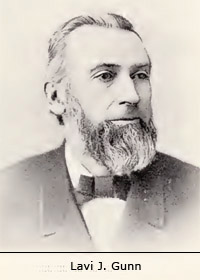 Both men were not only good employees and independent
contractors. Their ambitions were reaching much
farther and the goal was to establish themselves as an
independent business.
Both men were not only good employees and independent
contractors. Their ambitions were reaching much
farther and the goal was to establish themselves as an
independent business.
Levi J. Gunn had long
experience in manufacturing, gained during many years of
employment with Alonzo Parker.
Years later author
writes:
"His success in life is due to habits of thrift
and industry, and the economical management of the large
affairs with which he has been connected."
(Greenfield Gazette, Centennial Edition, February,
1892.)
Charles
H. Amidon brought an inventive mind to this team.
As early as 1856, in partnership with A. C. Hitchcock,
another employee at Greenfield Tool Co., he developed and
patented his first device - a Mortising Chisel.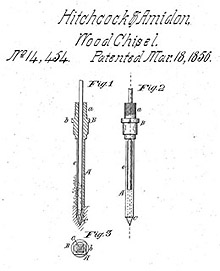
At the Greenfield Tool Factory, Amidon together with
Gunn were only two mechanics making plow and matching
planes - an "honor" given only to the most skilled
workers.
Aside from working for Greenfield Tool Co., Gunn and
Amidon began their own, small enterprise in building
clothes wringers.
The reason for engagement in this line of products
remains a mystery. We can only speculate that Gunn
and Amidon, being "tinkerers" by nature, were also
looking for opportunities to find a "hot" product that
was simple to build and easy to sell.
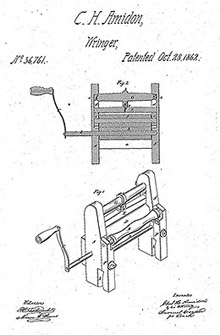 In early 1850s washing machines and accompanying
wringers became very desirable house appliances.
In 1851 James King patented the first washing machine to
use a drum. In 1858 first rotary washing machine
was invented by Hamilton Smith. By early 1860s
various patented wringers were available on the market.
In early 1850s washing machines and accompanying
wringers became very desirable house appliances.
In 1851 James King patented the first washing machine to
use a drum. In 1858 first rotary washing machine
was invented by Hamilton Smith. By early 1860s
various patented wringers were available on the market.
It was natural for Amidon to work on improvement to
existing wringer designs and have his own solution ready
for patent in 1862. He received this patent on
October 28, 1862 with a number 36,761.
Apparently, "the two had begun making wringers in
part of the old steam mill, near the original railroad
depot, while they were still employed by the Greenfield
Tool Company. When the steam mill burned in June,
1861, they stopped working for the tool company to begin
business on their own in the northwest corner of town."
(The Conservative Rebel by Paul Jenkins, 1982).
In
September, 1861,
Dunn, Amidon and Holland built shops on Gunny's Pond, a
spot in Cherry Rum Brook area above Nash's Mills.
"Cherry Rum Brook flows from
the west end of White Ash swamp, and continues westward
discharging into Mill Brook.
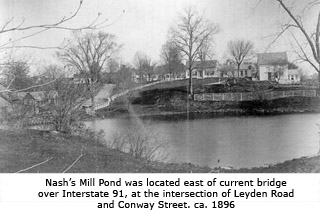 The thickets which
lined its winding way were cover for the
Indians who
attacked the retreating forces of Captain Turner, after
the Falls fight, and near its northern
bank some of the
captured soldiers were burned at the stake. Nearly
a century ago its waters turned the wheels of a sawmill,
which was located just east of where the swamp road
crosses the brook.
The thickets which
lined its winding way were cover for the
Indians who
attacked the retreating forces of Captain Turner, after
the Falls fight, and near its northern
bank some of the
captured soldiers were burned at the stake. Nearly
a century ago its waters turned the wheels of a sawmill,
which was located just east of where the swamp road
crosses the brook.
Dunn, Amidon and Holland
built the stone dam just west of the Boston and Maine
Railroad, and here began the existence of the prosperous
business."
In April, 1862 Gunn and Amidon completed the road
connecting their shops with Silver Street and gained
comfortable access to Conway Street, one of the main
arteries in Greenfield.
"Their product received immediate, widespread
attention, winning an award at a national industrial
exhibition." (The Conservative Rebel by Paul
Jenkins, 1982).
Even before the date of his patent, October 28, 1862, Amidon
presented his wringer design at the Twenty Second annual Fair
held in Rochester, NY during September 30 and October 3, 1862.
He received a recognition diploma for his improved wringer.
According to R. Roeder, (oldtoolheaven.com)
the success of the wringer patented by Amidon, prompted Levi J.
Gunn to formalize relationship with Charles H. Amidon and the
business adopted a name of "Gunn & Amidon". Up to this
point the business was rather informal association of Levi J.
Gunn and Charles H. Amidon.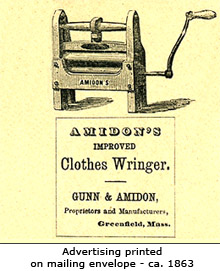
On September 6th, 1864, First Annual Exhibition of the New
England Agricultural Society, formed that year, opened its review of
agricultural and related
industrial achievements in Springfield, MA. Gunn &
Amidon presented eight samples of their improved wringer.
The wringers were based on a patent received by Amidon in 1862.
Although Gunn & Amidon did not receive an award for
their presentation, another important event took place
on the floor of the exhibition. The wringers
presentation was entered in the Class IX, No. 46 -
Agricultural Implements Entries. In the
Exhibition catalog Gunn & Amidon are listed at entry No.
136.
The next entry, No. 137, was for W. H. Barber
from Greenfield, MA. He presented one Barber's
Patented Bit Brace.
